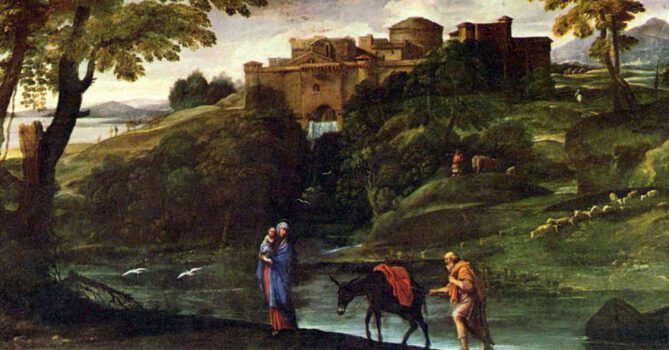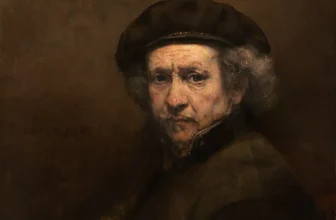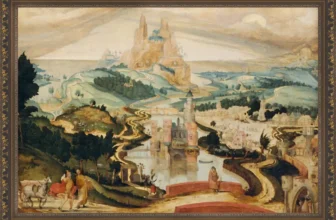A Deep Dive into Sacred Symbolism and Artistic Mastery
Art has long served as a vessel for storytelling, spiritual reflection, and cultural memory. Few works exemplify this role better than “Flight into Egypt” (c. 1604) by Annibale Carracci, a pivotal figure in the transition from Mannerism to the Baroque. This remarkable painting, held today at the Galleria Doria Pamphilj in Rome, is more than a biblical narrative, it is a poetic synthesis of naturalism, classical harmony, and spiritual depth.
In this post, we explore the layered meaning of Flight into Egypt, unpacking its symbolism, theological significance, visual narrative, and artistic context. This painting stands as a seminal moment in the history of Western art, not just for its technical brilliance, but for how it redefined the way sacred stories could be told on canvas.
What Is “Flight into Egypt” All About?
The painting illustrates a biblical scene drawn from the Gospel of Matthew (2:13–15), in which Joseph, Mary, and the infant Jesus flee to Egypt to escape King Herod’s decree to massacre all male infants in Bethlehem. This tragic and dangerous journey is portrayed here with serene grace, inviting the viewer to reflect on divine protection, human vulnerability, and the omnipresence of God’s plan.
Carracci’s version of this well-known story is not about panic or despair. Instead, it evokes a sense of calmness, order, and divine guidance. The Holy Family is shown traveling through a vast, idealized landscape that dominates the composition. The choice to place the family in a harmonious, pastoral setting instead of a chaotic desert or perilous mountain pass was both a theological and artistic decision, rich in symbolism.
What Is Happening in the Painting?
The painting captures a moment of transition, a journey in progress. In the center-left, the Virgin Mary rides a donkey, holding the infant Jesus. Joseph leads the donkey, guiding the family forward. They are accompanied by a figure playing a violin, often interpreted as an angel providing divine accompaniment for their journey. Several shepherds and rustic figures populate the midground, reinforcing the pastoral ambiance.
However, it is not simply a genre scene or a literal retelling of scripture. The real subject, many scholars argue, is divine protection and providence, with the vast, almost Edenic landscape reinforcing this theme. The Holy Family is small in comparison to their surroundings, emphasizing their humility and the spiritual magnitude of the journey. The deliberate quietude and equilibrium in the scene signal a turning point in sacred art: a move from the dramatic and stylized Mannerism of the late 16th century toward the clarity and realism that would define the Baroque.
Symbolism and Interpretation
1. The Landscape as Theology
One of the most radical aspects of Flight into Egypt is that the landscape takes center stage, dwarfing the human figures. This was a significant departure from earlier religious paintings, where the sacred figures were typically front and center. Carracci makes the landscape a theological agent, it is as if nature itself becomes a witness to divine action.
The serene hills, clear skies, and peaceful herds suggest divine order and the promise of salvation.
The still waters and greenery evoke the imagery of Psalm 23: “He makes me lie down in green pastures. He leads me beside still waters.”
The path winding into the distance symbolizes the journey of life, guided by faith and grace.
2. The Angel with a Violin
The inclusion of an angel playing a violin is not strictly biblical but rather symbolic. The music represents divine harmony, a guiding spiritual force that helps ease the trials of the earthly journey. This figure may also symbolize the idea that even in exile, God’s presence brings beauty and peace.
3. The Donkey and the Journey
The donkey, traditionally associated with humility and service, reinforces Mary’s role as the handmaiden of the Lord. The act of movement, a journey taken out of necessity, has been interpreted as a metaphor for the pilgrimage of faith, with Joseph as the guardian and Mary as the vessel of divine incarnation.
4. The Use of Light and Atmosphere
Carracci uses subtle lighting and atmospheric depth to create a scene filled with tranquility. The soft glow on the horizon suggests hope and divinely ordained direction. Light here is both literal and symbolic: a guide through darkness, a representation of divine presence.
5. The Shepherds and Secondary Figures
Secondary figures, such as shepherds in the midground, contribute to the theme of pastoral peace and may symbolize the common people who are also protected by divine providence. Their presence grounds the scene in the earthly realm while emphasizing the universal relevance of the Holy Family’s journey.
Artistic Style: A Synthesis of Classicism and Naturalism
Carracci’s Flight into Egypt is often described as a watershed moment in the evolution of landscape painting and religious art. It represents a fusion of High Renaissance balance, naturalistic detail, and emerging Baroque dynamism, although the tone here remains contemplative rather than theatrical.
1. A New Kind of Religious Art
Where earlier depictions of the same subject emphasized drama, angels, and miraculous signs, Carracci’s painting leans into human vulnerability and divine simplicity. It reflects the ideals of the Counter-Reformation, which called for religious art that was clear, emotionally engaging, and doctrinally sound. Rather than overwhelming the viewer with divine spectacle, Carracci draws them into the intimacy of a quiet moment during an extraordinary journey.
2. The Ideal Landscape
Carracci was heavily influenced by Venetian and Central Italian painters, particularly Titian and Raphael. However, he synthesized their styles into something new. The landscape is not a direct representation of a real place but an idealized vision, a spiritual Eden, that elevates the narrative. Trees, rivers, animals, and hills are composed with geometric balance, echoing the classical ideals of harmony.
3. The Human Figure
While the Holy Family is not presented with exaggerated emotion or theatrical gestures, their serenity is deliberate. Carracci imbues them with a dignified realism, Mary’s posture, Joseph’s steady hand, and the infant Jesus’ quietude all contribute to the sense of divine peace.
Historical Context
1. Carracci and the Bolognese School
Annibale Carracci (1560–1609) was a leading figure of the Bolognese School, which aimed to reform art away from the artificiality of Mannerism and back to the balanced classicism of the High Renaissance, enriched by natural observation. Together with his brother Agostino and cousin Ludovico, Carracci established an academy in Bologna that championed drawing from life, careful study of nature, and fidelity to human anatomy.
2. Commission and Patronage
“Flight into Egypt” was commissioned by Cardinal Pietro Aldobrandini for his Roman palace, which reflects both personal devotion and the broader Church agenda during the Catholic Reformation. The painting was intended to reflect Catholic piety, clarity of doctrine, and the beauty of God’s creation. In a time when Protestant reformers had criticized religious images as idolatrous, Carracci’s work responded with subtlety, grace, and orthodoxy.
Carracci’s painting had a profound impact on the development of landscape painting and religious art in the 17th century. Artists like Claude Lorrain, Nicolas Poussin, and Domenichino drew heavily from this model of the ideal landscape populated with sacred or mythological figures. The idea that landscape could carry theological or emotional meaning would shape European art for generations.
Moreover, Carracci’s ability to balance narrative clarity with emotional resonance helped define the early Baroque aesthetic, one that would soon find even more expressive development in the works of Caravaggio, Rubens, and Bernini. However, where Caravaggio brought drama and chiaroscuro, Carracci offered light, order, and pastoral calm, a different, yet equally powerful, form of spiritual engagement.
Where Is the Flight into Egypt Painting Today?
Annibale Carracci’s Flight into Egypt is housed in the Galleria Doria Pamphilj, a private art gallery in Rome, Italy. This institution holds one of the most significant private collections of Italian Baroque art, featuring works by Caravaggio, Raphael, Velázquez, and Titian. The painting remains one of its prized pieces, appreciated for both its aesthetic qualities and historical significance.
Visitors to the gallery can view the painting in its intimate setting, a reminder that great works of art were not always intended for public museums but often adorned private chapels, palaces, and devotional spaces. The setting allows for a reflective encounter with the painting, in keeping with its quiet spiritual tone.
Annibale Carracci’s Flight into Egypt is more than a beautiful painting, it is a cornerstone in the evolution of Western art. Through its masterful composition, spiritual symbolism, and revolutionary integration of landscape and narrative, the work continues to captivate and inspire. It bridges past and future, faith and form, heaven and earth.
In depicting a sacred flight with such gentleness and grace, Carracci invites us to find the divine not in spectacle but in the everyday, a message that remains as profound now as it was over 400 years ago.




